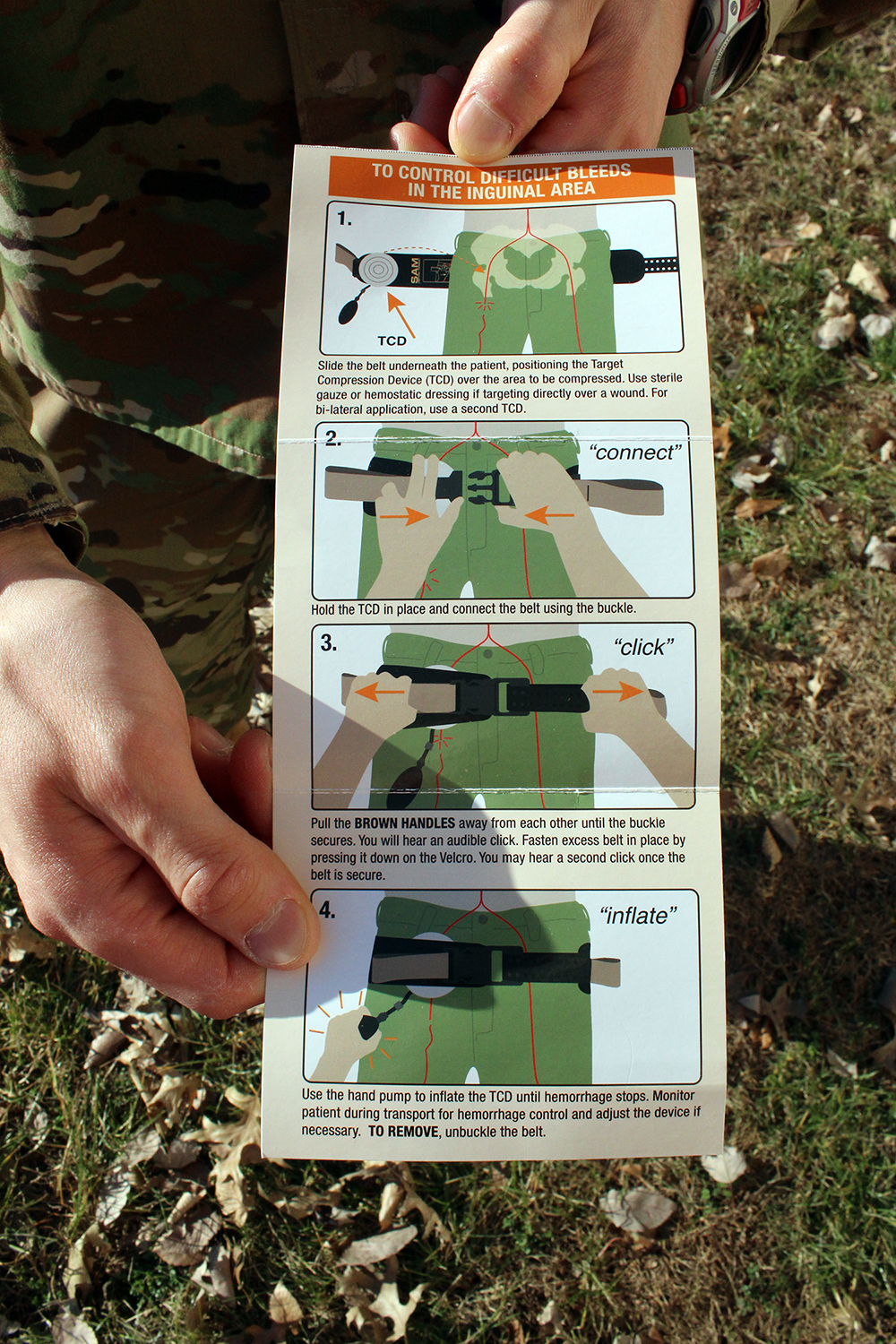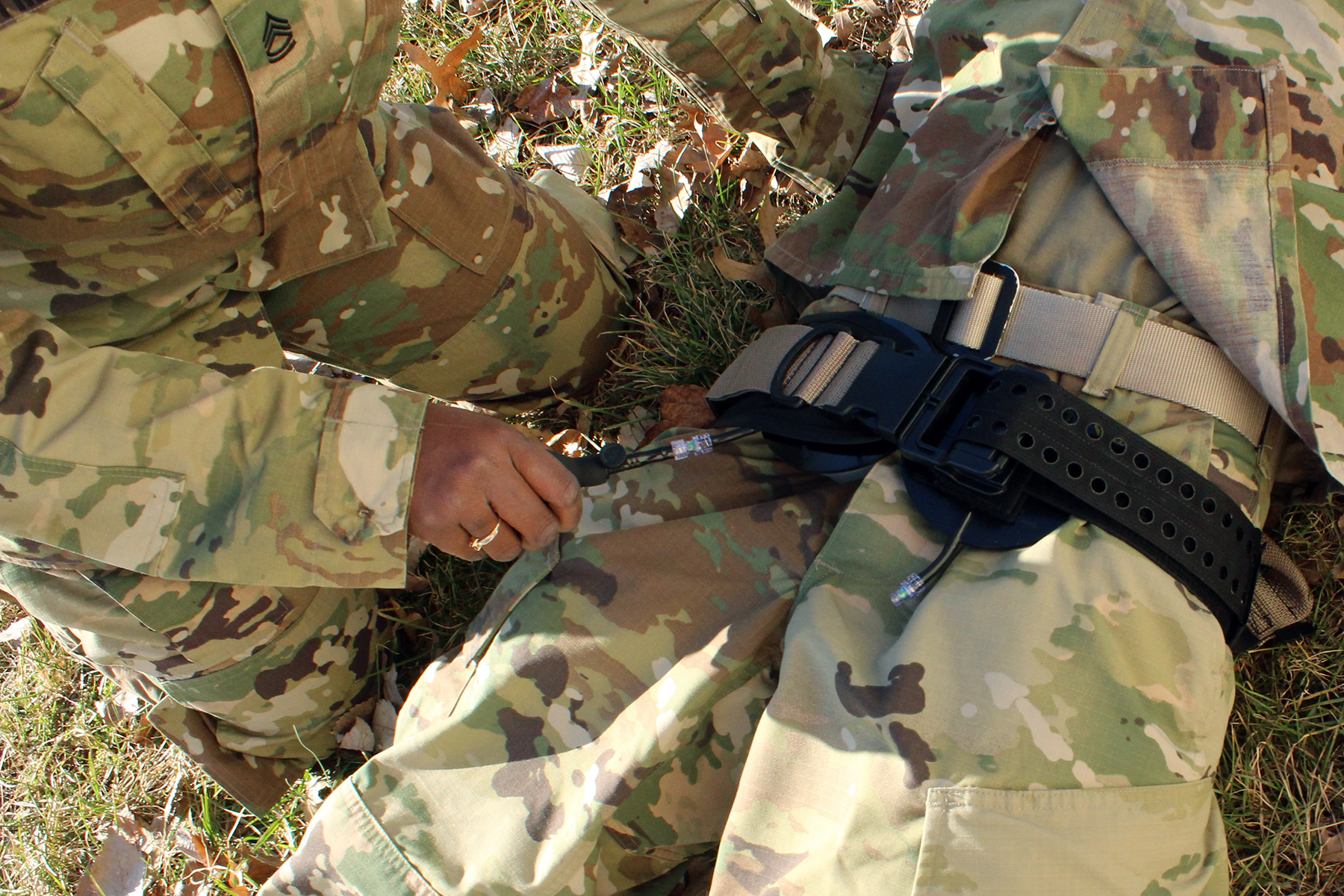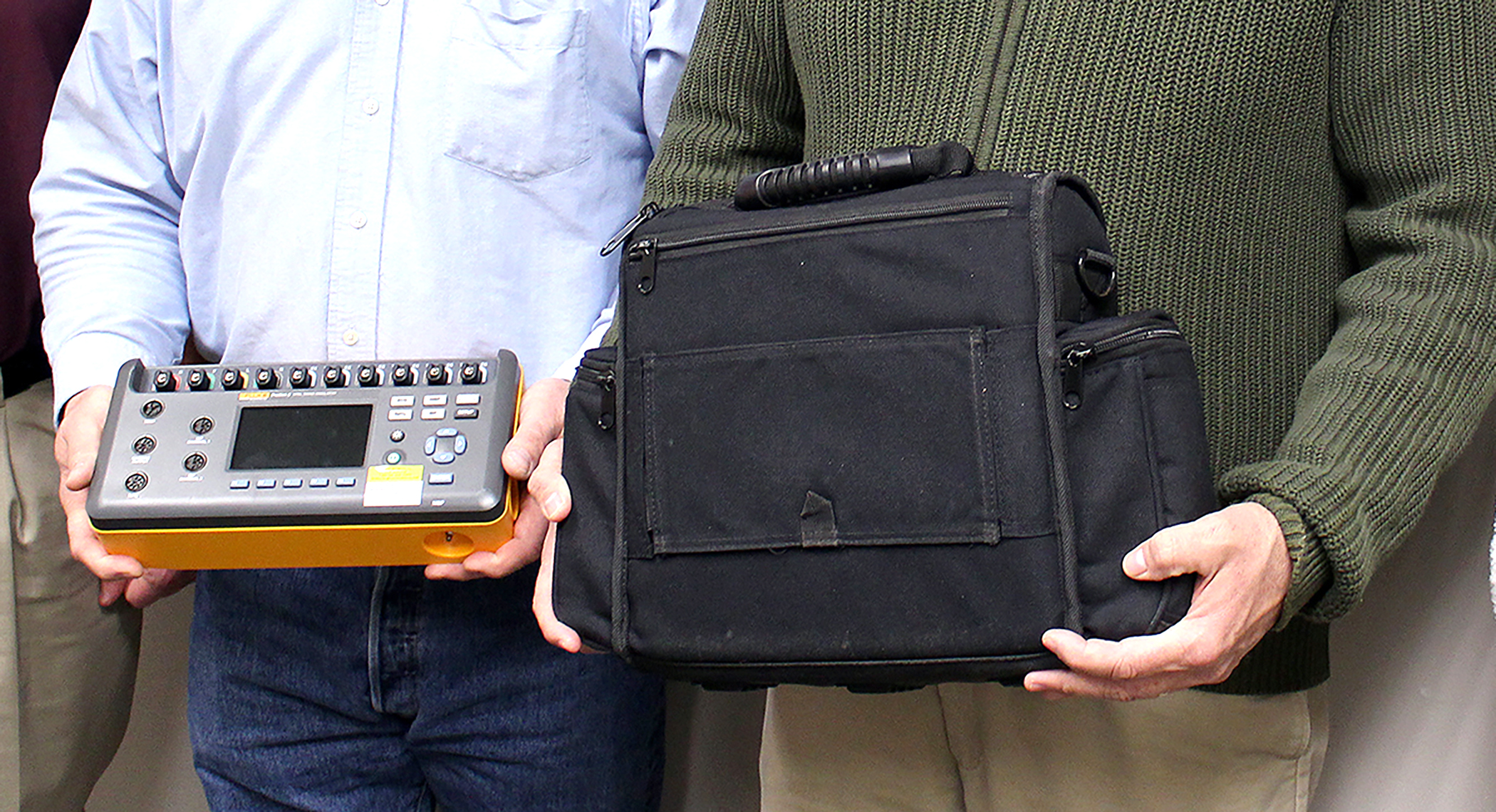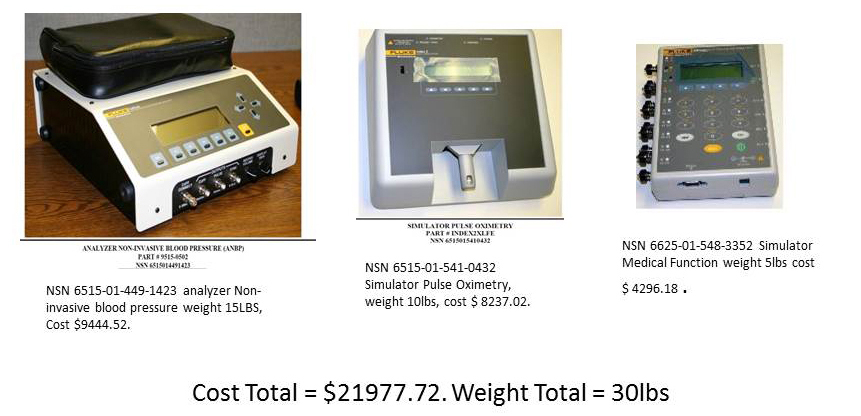
By Col. David R. Gibson
It is no secret that the Army is in a time of great budget uncertainty and growing mission complexity. The velocity of this instability has increased substantially since the FY16 spending cap was set almost four years ago. Meanwhile, budgetary pressures build in light of the geopolitical reality unfolding around the world. The Army is faced with making risk-based tradeoffs among a portfolio of capabilities used to address known and unknown global contingency missions.

The junctional tourniquet is designed like a belt with air bladders that can be positioned in about 60 seconds – a crucial factor for combat medics who only have mere minutes to save a fellow Warfighter’s life if he or she is hemorrhaging. (All photos by Ellen Crown, USAMMA public affairs)
In this context, Army medicine must pursue the development, procurement, fielding and sustainment of materiel solutions that optimize agility and flexibility. While the Army’s current missions may be widely diverse, some aspects are common: Our Soldiers need solutions that are smaller, lighter, easier to transport and less costly to maintain.
In short, medical materiel solutions must provide required capabilities, but they must do so in ways that don’t create secondary storage, transportation or sustainment burdens.
As a subordinate organization of the Army’s medical materiel developer, the U.S. Army Medical Research and Materiel Command (USAMRMC), the U.S. Army Medical Materiel Agency (USAMMA) is continually looking for ways to develop, tailor, deliver and sustain medical materiel capabilities and data in order to build and enable health readiness. Feedback from the battlefield and collaboration with industry are essential parts of our acquisition process. For example, over recent years biomedical equipment specialists have described issues with their gear, which included multiple instruments used to test, calibrate and repair medical equipment, as being too bulky and heavy for a field environment.
Looking to provide this critical capability in a smaller package, the USAMMA worked with the Fluke Corp. to procure the Medical Vital Signs Simulator (MVSS). The MVSS performs the functions of three instruments, including the analyzer noninvasive blood pressure; the simulator medical functions; and the simulator pulse oximetry. Because it is a single device instead of three, the MVSS also reduces shipping weight from 30 pounds to 12 pounds and shipping size from 2.5 cubic feet to 0.25 cubic feet.
Another great example of industry collaboration is the P2131 automated field steam sterilizer, which the USAMMA selected and began fielding in late 2015 to phase out the M-138 steam sterilizer the Army had used for more than 50 years. Steam sterilizers are used in combat support hospitals to clean medical instruments.

The U.S. Army Medical Materiel Agency (USAMMA) is fielding a new junctional tourniquet designed to save Warfighters from bleeding to death on the battlefield. Junctional tourniquets are designed to stop the bleeding in the groin or armpit area where the Combat Application Tourniquet cannot be used.
The USAMMA worked closely with Fort Defiance Industries Inc. to develop the P2131, which is about the same size and weight as the old system but has greatly increased capability. The P2131 has a water recovery system that allows it to use 90 percent less water – 10 gallons of water to process up to 100 loads – compared with 250 gallons used by the previous model.
The biggest benefit to this solution, however, is the reduction in sustainment costs. The M-138 model had a tendency to run low on water and continued to heat, which caused significant damage to the sterilizer. The water recovery system on the P2131 mitigates this issue. Also, the P2131 has a water softener expected to decrease the amount of times the heating elements will have to be cleaned and replaced, which will decrease cost for parts. With the M-138, replacing and cleaning the heating elements was a yearly activity.
These adjustments and others will cut the 20-year total life cycle cost management (e.g., sustainment costs) of the P2131 by 30-40 percent, from $31,000 to $19,000 per system. The full operating capability for the Army is 475 steam sterilizers, reaping a cost savings of $5.7 million across the force.
Modernization efforts, such as the MVSS and the P2131, are one way we are able to provide essential capabilities to the warfighter in a smaller, lighter and sustainable package. Additionally, industry has greatly helped us to provide new capabilities. One example of this is the junctional tourniquet, produced by SAM Medical Product, which the USAMMA began fielding in 2016.
Exsanguination, or bleeding to death, is the most common cause of potentially survivable death to wounded warfighters. Groin and pelvic injuries (i.e., junctional injuries) have become increasingly common because of the enemy’s use of improvised explosive devices (IEDs). Blasts from IEDs often cause pelvic fractures and high leg injuries, which result in massive blood loss (i.e., hemorrhage) if not immediately treated.
The SAM junctional tourniquet provides a new capability in a package that weighs about 1 pound, straps on like a belt and includes two inflatable air bladders that medics can inflate individually or both at the same time. The device is designed so that a person can position it in under a minute – a crucial factor for combat medics who only have mere minutes to save a fellow warfighter’s life if he or she is hemorrhaging.

USAMMA is fielded a new water-efficient vacuum steam sterilizer, the model P2131 Automated Field Steam Sterilizer (pictured), for combat support hospitals that only uses 10 gallons of water to process up to 100 loads of sterilized medical instruments.
This example also demonstrates the incredible collaboration within the Department of Defense to ensure we equip warfighters with the best solutions. The U.S. Army Institute of Surgical Research (USAISR), as well as the Naval Medical Research Unit San Antonio (NAMRU-SA), tested the SAM junctional tourniquet to ensure it met the needs of the warfighter. The USAMRMC test branch performed altitude testing. Additionally, the Army’s Capability Development Integration Directorate performed form, fit and function tests on the device’s attachable sack, or molle bag, which fastens to the combat medic bag.
Earlier this year, the USAMMA started the fielding process to update specific Army’s sets, kits and outfits (SKO) with the new junctional tourniquets. The USAMMA worked closely with the U.S. Army Medical Materiel Development Activity (USAMMDA), also a subcommand of the USAMRMC, to update the ground ambulance and air ambulance SKOs. USAMMA also began updating the tactical combat medical company and forward surgical team SKOs. Additionally, USAMMA is updating the combat medic bag SKOs to include a junctional tourniquet and molle bag.
Since the devices are one-time-use items, the new junctional tourniquet can be supplied with the bag or separately with the tourniquet on its own. Being able to order and field the tourniquet without the bag for those who already have a carrying case will help the Army avoid unnecessary costs and logistical burden.
These examples are just a few of the most recent acquisitions within Army medicine to provide medical materiel solutions that are smaller, lighter, easier to transport and less costly to maintain. Every inch and ounce counts when equipment and supplies are transported globally or while being carried on the back of a Soldier. We must do all we can to lighten their load with affordable and sustainable solutions.
If you have an idea or product you think would benefit warfighters, go to http://mrmc-npi.amedd.army.mil/.
Check us out on the web: www.usamma.amedd.army.mil.

USAMMA has selected and begun fielding a new Medical Vital Signs Simulator (pictured) for testing, calibrating and repairing medical equipment such as vital signs monitor and pulse oximeters. The MVSS fits into a small carry-on bag (pictured) and weighs less than five pounds.
COL. DAVID R. GIBSON is commander of USAMMA and the medical acquisition consultant to the Army surgeon general.. He holds a master’s in public administration from Murray State University, an M.S. in real estate and construction management, an MBA from the University of Denver in Colorado, a masters in national security and resource strategy from the Eisenhower School – National Defense University and a bachelor’s degree from the University of Central Oklahoma. He is a graduate of the U.S. Army Medical Department basic and advanced courses, the Command and General Staff College, the U.S. Army War College defense strategy course and the Defense System Management College. He is a fellow of the American College of Healthcare Executives; a fellow and current Chair of the Fellow Committee of the Association for Healthcare Resource and Materials Management; and holds the project management professional and certified materials and resource professional designations. He is a member of the Defense Acquisition Corps, is Level III certified in program management and Level II certified in life cycle logistics.








